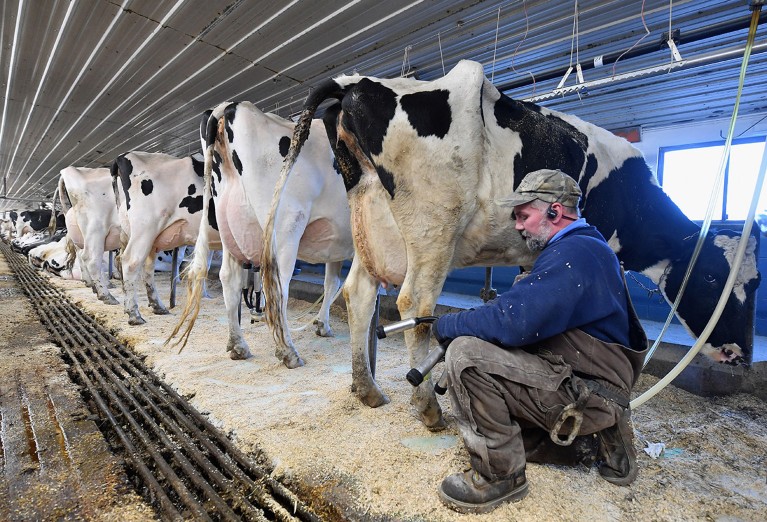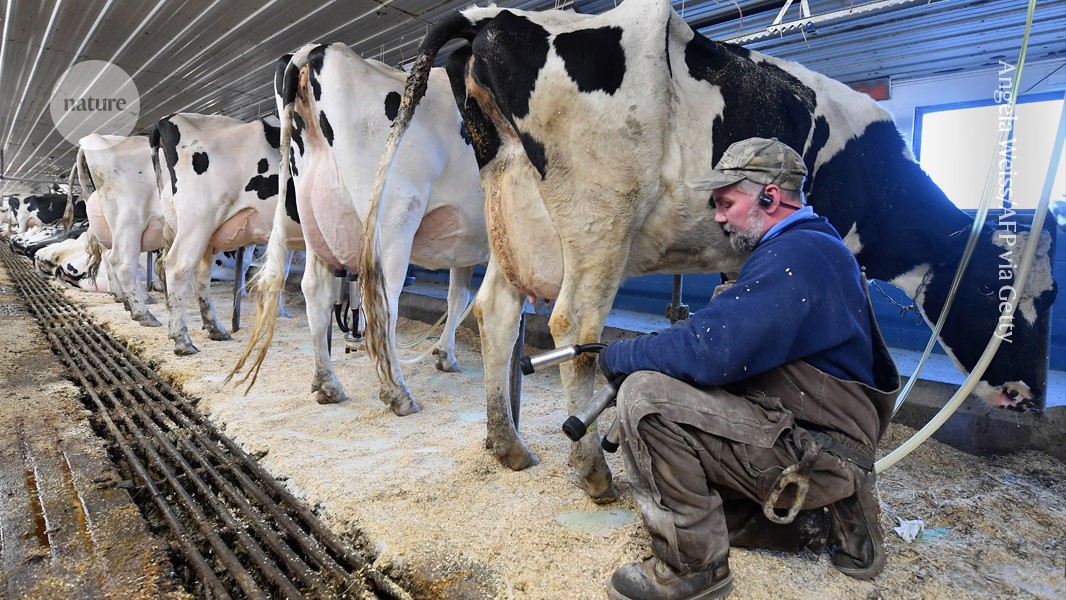
Cows are milked on a farm in New York State.Credit score: Angela Weiss/AFP by way of Getty
The outbreak of avian influenza in US dairy cattle exhibits no indicators of slowing. Over the previous three weeks, the variety of states the place cows contaminated with hen flu have been detected has risen from six to eight. A preprint1 posted on 16 April reported the invention of the virus in uncooked milk from contaminated cows, and US federal authorities stated on Wednesday that the virus had been present in lung tissue collected from a seemingly wholesome cow.
Additionally on Wednesday, US officers confirmed at a media briefing that genomic materials from the H5N1 pressure, which is inflicting the outbreak, had been detected in milk bought in retailers.
Detection of viral particles in milk bought to shoppers means that avian flu in cows might “be extra widespread than initially thought”, says meals scientist Diego Diel at Cornell College in Ithaca, New York. “Elevated surveillance and testing in dairies needs to be an vital a part of management measures going ahead.” Nature seems to be on the implications for human well being and the way forward for the outbreak.
What does it imply that H5N1 is in retail milk?
It’s nonetheless unclear what number of milk samples the FDA has examined or the place the samples have been collected. The company stated that it could launch extra data within the coming days and weeks.
After it leaves the farm and earlier than it hits the cabinets, milk is pasteurized to inactivate pathogens. To detect H5N1, the FDA used a take a look at referred to as quantitative polymerase chain response (qPCR), which picks up viral RNA. As a result of it detects fragments of the viral genome, the take a look at can not distinguish between dwelling virus and the remnants of useless virus, says dairy scientist Nicole Martin at Cornell College.
Fowl flu outbreak in mink sparks concern about unfold in individuals
“The detection of viral RNA doesn’t itself pose a well being danger to shoppers, and we anticipate finding this residual genetic materials if the virus was there within the uncooked milk and was inactivated by pasteurization,” she says.
The presence of viral materials in commercially obtainable milk does have broader implications, nevertheless. There are a number of potential explanations, says virologist Brian Wasik, additionally at Cornell College. It could possibly be that the outbreak is extra pervasive than farmers realized, and that milk from contaminated animals is getting into the industrial provide. One other chance, he says, is that “asymptomatic cows that we aren’t testing are shedding virus into milk”. But it surely’s additionally potential that each eventualities are true.
US federal guidelines require milk from contaminated cows to be discarded, however it’s not but clear whether or not cows typically begin shedding the virus earlier than they appear sick or produce irregular milk. The 16 April preprint, which has not but been peer reviewed, contains studies that milk from contaminated cows is thicker and extra yellow than typical milk and that contaminated animals eat much less and produce much less milk than normal.
Is milk with traces of H5N1 in it a menace to people?
There isn’t a definitive proof that pasteurization kills H5N1, however the methodology kills viruses that multiply within the intestine, that are hardier than flu viruses, says Wasik. “Influenza virus is comparatively unstable,” he says, “and may be very prone to warmth.” Pasteurization of eggs, which is completed at a decrease temperature than pasteurization of milk, does kill H5N1.
It’s potential that pasteurization can be much less efficient at killing comparatively excessive viral concentrations in milk, says Wasik. Discovering out whether or not that is the case requires experimental knowledge. Within the absence of a definitive reply, protecting milk from contaminated cows out of the industrial provide is extraordinarily vital.
When Nature requested when to count on extra proof on whether or not pasteurization kills H5N1, Janell Goodwin, public-affairs specialist on the FDA in Silver Spring, Maryland, stated that the company and the US Division of Agriculture (USDA) “are working intently to gather and consider extra knowledge and knowledge particular to” H5N1.
Is milk spreading hen flu amongst cows?
USDA researchers have examined nasal swabs, tissue and milk samples of cows from affected dairy herds and have discovered that milk contained the very best viral concentrations. This means that the virus could possibly be spreading by milk droplets.
Fowl-flu menace disrupts Antarctic penguin research
If that’s the case, milking tools could possibly be concerned. “The teat cups of a milking machine might switch remnants of H5N1-containing milk from one cow to the teats of the subsequent cow being milked,” says virologist Thijs Kuiken at Erasmus College Medical Centre in Rotterdam, the Netherlands. “Even when they’re washed and disinfected, the degrees of virus within the milk of contaminated cattle are so excessive that one couldn’t exclude the potential for infectious virus being transferred from cow to cow by this route.” In actual fact, in some tools set-ups, staff spray down milking machines with high-pressure hoses to scrub them, which might aerosolize any contaminated milk, says Wasik.
The USDA web site concurs that viral unfold is “seemingly by mechanical means”.
Is sufficient being accomplished to cease the unfold?
The FDA introduced on Wednesday that cows should take a look at unfavorable for hen flu earlier than they are often moved throughout state strains. That may assist to stem the outbreak, scientists say. Animals within the US dairy business transfer round so much, Wasik says. Calves are moved to be raised into milk cows, cows are moved once they cease producing milk and farmers promote the animals. Such motion might be “a predominant driver” of the outbreak, Wasik says.
Diel wish to see surveillance of bulk milk samples at farms. Wastewater testing and environmental sampling could possibly be helpful, too, Wasik says, significantly round farms close to outbreaks or farms the place cows have been moved. He additionally advocates for a quarantine or commentary interval of 24 or 48 hours when cattle are moved to a brand new farm.
Such surveillance measures “might actually purchase us time, decelerate the outbreak”, says Wasik, so researchers and businesses can “get a greater deal with on it. As a result of time is what’s of the essence.”



